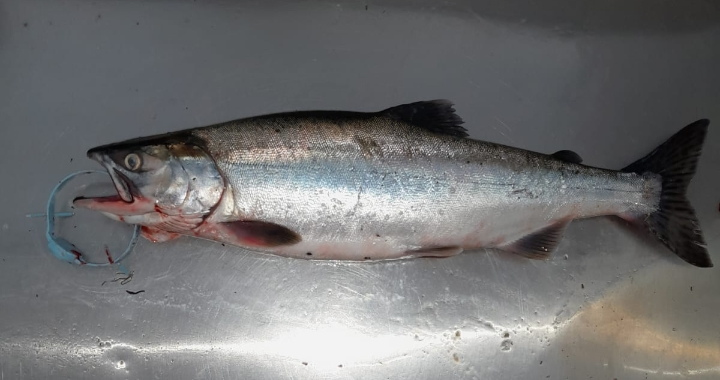The first pink salmon of 2023 has been landed in Ireland at Ridge Pool of the Moy Fishery on June 25, confirming fishery managers’ fears

This pink salmon was caught on the Ridge Pool on the Moy at Ballina on June 25.
A pink salmon, an alien salmonid species believed to have migrated south from Russia, has been caught from Inland Fisheries Ireland’s (IFI) Ridge Pool, on the river Moy at Ballina, Co Mayo.
In mid-May, the state fishery body IFI issued an alert for anglers to look out for pink salmon (Oncorhynchus gorbusca) on all Irish rivers. The fish has a predominantly two-year life-cycle, and in 2017, 2019 and 2021 this non-native fish species unexpectedly appeared in unprecedented numbers in multiple river systems in the south-west, west and north-west of Ireland. As a result, the chances of this species reappearing in Irish rivers in 2023, a so-called ‘odd’ year, was high. This caprture confirms those fears.
Dr Michael Millane, Senior Research Officer at IFI said: “The presence of large numbers of this non-native species potentially pose a competitive threat to the survival of our native species such as Atlantic salmon and sea trout, as well as estuarine and coastal marine fish species – and their associated ecosystems”, and he urged anglers to be vigilant and report any findings – even of dead specimens – urgently.
Also known as humpback salmon, pink salmon are a migratory species, native to river systems in the northern Pacific Ocean and nearby regions of the Bering Sea and Arctic Ocean. There are also established populations in rivers in northern Norway and in the adjacent far northwest of Russia, originating from stocking programmes undertaken in this part of Russia since the 1950s until 2001.
Anglers, or the public, are asked to report encounters with pink salmon to IFI’s 24/7 phone number, 0818 34 74 24, or via info@fisheriesireland.ie. They are also asked to carry out the following actions:
• Photograph the fish.
• Retain the salmon and don’t put it back into the water (even in rivers only open for catch-and-release angling).
• Record the date and location of capture, and the length/weight of the fish.
• Tag the fish and present it to IFI staff, and a new tag will be issued to replace the tag used.
• The nearest local IFI staff will arrange collection of the fish for further examination.
Pacific pink salmon are blue-green to steel blue on the back, with silver sides and a white under-belly, and can be distinguished by several unique characteristics, which are different to Atlantic salmon, notably:
• Upper jaw typically extending beyond the eye
• Males develop a pronounced humpback on entering freshwater
• Large black oval spots on the tail
• 11-19 rays on the anal fin
• Very small scales – much smaller than a similarly-sized Atlantic salmon
• No dark spots on the gill cover



